Key takeaways:
- Understanding the roots of conflict and approaching it with empathy can transform disputes into collaborative resolutions.
- Active listening and clear communication are vital strategies for effective conflict resolution, enhancing understanding and satisfaction.
- Evaluating the outcomes of conflicts helps identify areas for improvement and fosters personal growth and stronger relationships.
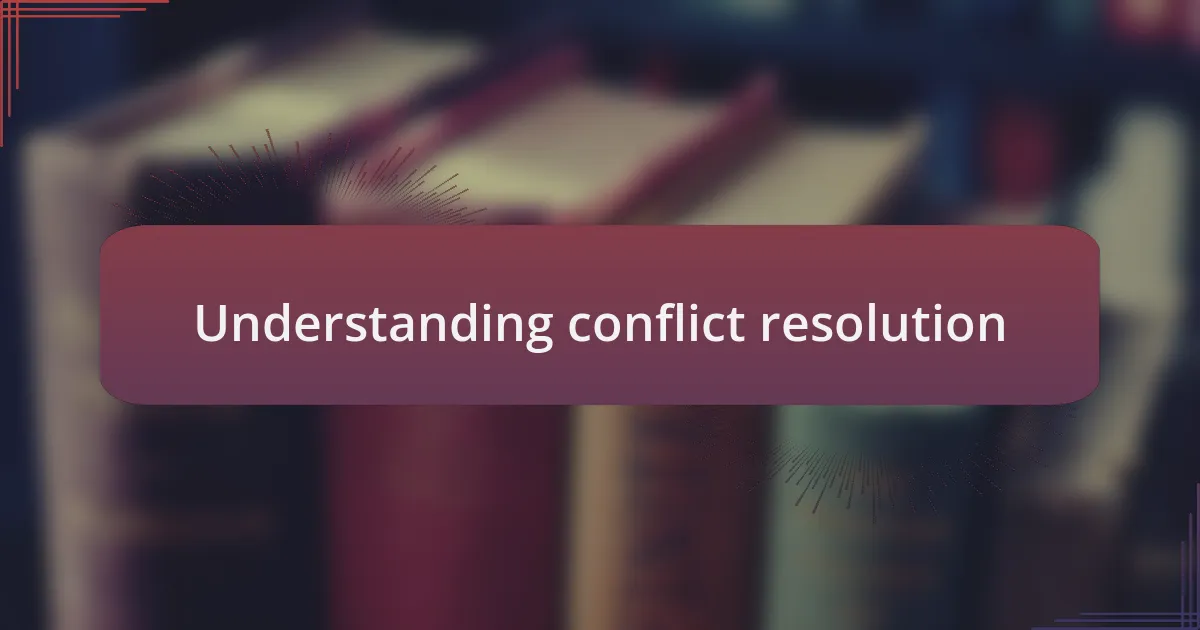
Understanding conflict resolution
Conflicts, no matter how small, can stir up a whirlwind of emotions. I remember a time when a simple misunderstanding with a colleague led to a heated debate over a project we were both passionate about. This experience taught me that understanding the roots of conflict is crucial; after all, isn’t it often just about two different perspectives colliding?
Resolution isn’t about winning or losing; it’s about finding common ground. I’ve found that asking open-ended questions can facilitate healthier discussions. Have you ever noticed how simply clarifying your viewpoint can shift the dynamic? It’s remarkable how a willingness to listen can transform tension into collaboration.
Moreover, I’ve realized that approaching conflicts with empathy makes a significant difference. When I paused to see things from the other person’s viewpoint, it often revealed underlying issues that both parties needed to address. Wouldn’t you agree that empathy paves the way for not just resolution but also stronger relationships?
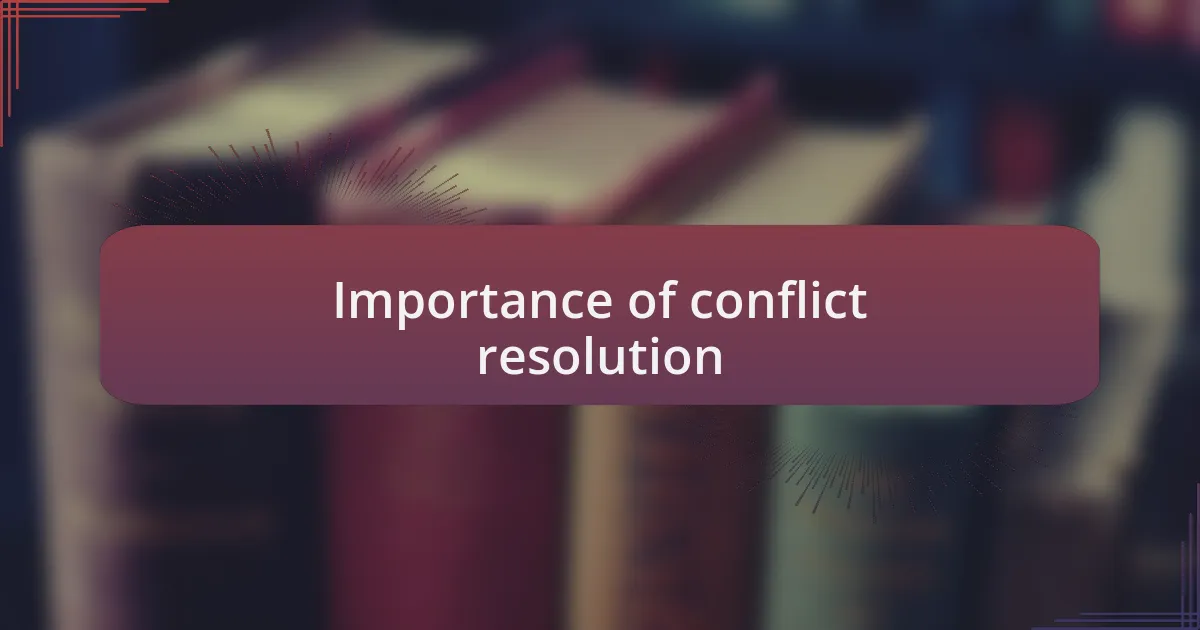
Importance of conflict resolution
Resolving conflicts is essential in maintaining healthy relationships, both in personal and professional spheres. I recall a time when a disagreement with a long-time friend over differing opinions nearly strained our bond. It was only through active listening and open communication that we could restore our connection, highlighting how resolution can be a bridge rather than a barrier.
Consider the impact of unresolved conflicts; they can lead to stress, anxiety, and a toxic environment. In my experience, when tensions simmer beneath the surface, it affects not just the individuals involved but also those around them. Have you ever witnessed a team become less productive because of unresolved issues? It makes you realize that addressing conflicts promptly can enhance overall morale and productivity.
The process of conflict resolution also fosters personal growth and understanding. I’ve learned that every conflict offers an opportunity for self-reflection and development. When I confront and navigate disagreements, I become more resilient and adaptable. Isn’t it fascinating how conflict can actually be a catalyst for personal and collective growth?
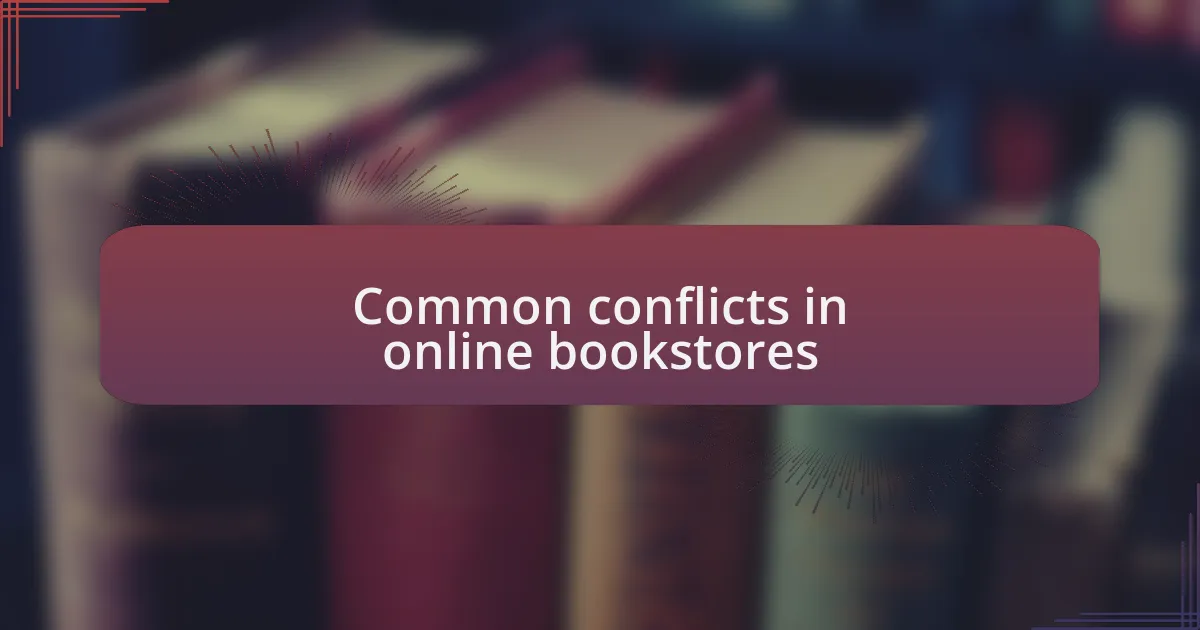
Common conflicts in online bookstores
Conflicts in online bookstores often arise from issues like incorrect product listings or pricing errors. I remember a time when a friend ordered a limited edition book, only to receive a different title due to a clerical oversight. It was frustrating for him, as he had been eagerly waiting for that specific book. This kind of confusion not only disappoints customers but can also stain their trust in the bookstore.
Another common conflict involves shipping mishaps. Delays or lost packages can make customers feel neglected. I once ordered a book that took weeks to arrive, leading me to question the reliability of the service. I couldn’t help but wonder, how do you build lasting customer relationships when such setbacks occur? When these situations arise, prompt communication can go a long way in alleviating frustrations.
Lastly, differing expectations regarding return policies can trigger disputes. Customers sometimes assume they can return a book without restrictions, but bookstores often have specific guidelines. I recall a situation where a return didn’t go as planned, and it left both the customer and the store feeling unsettled. Does your return policy truly meet customer expectations? Ensuring clarity in these policies can prevent misunderstandings and foster greater satisfaction.
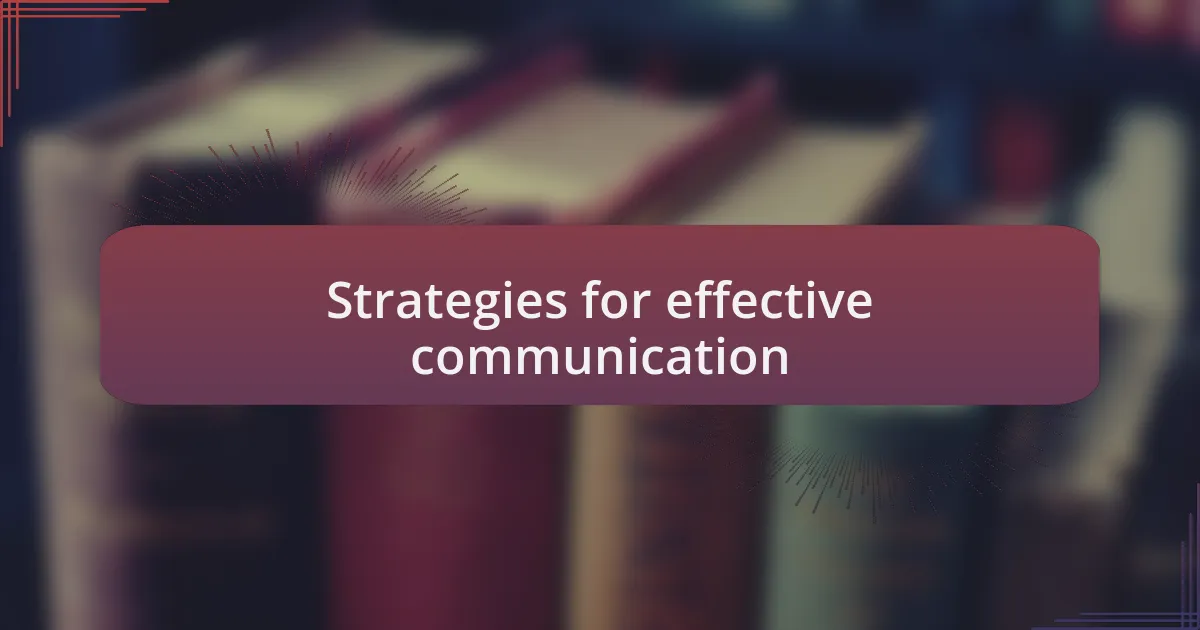
Strategies for effective communication
Effective communication starts with Active Listening. I remember a particular instance when I had a heated discussion about a delayed order with a customer service representative. Instead of immediately diving into solutions, she listened intently to my concerns. Just that simple act made me feel valued, and it transformed a potentially negative experience into a constructive dialogue. Have you ever felt more reassured simply because someone was truly paying attention?
Being clear and concise is another vital strategy. I often find myself frustrated when I receive vague responses during conflicts. For example, I once inquired about a missing book and got an answer sprinkled with jargon, which left me more confused than before. By using straightforward language and directly addressing the issue, both customers and businesses can avoid unnecessary frustration. How can clarity change the way we resolve issues in the fast-paced world of online shopping?
Finally, empathy can turn challenging conversations into opportunities for growth. During a chat about a wrong shipment, I expressed my disappointment, and the customer service agent responded with genuine understanding. This human connection created a bridge between us, easing tension instantly. Wouldn’t it be refreshing if all customer interactions came with a touch of empathy? Communication isn’t just about words; it’s also about feeling heard and understood.
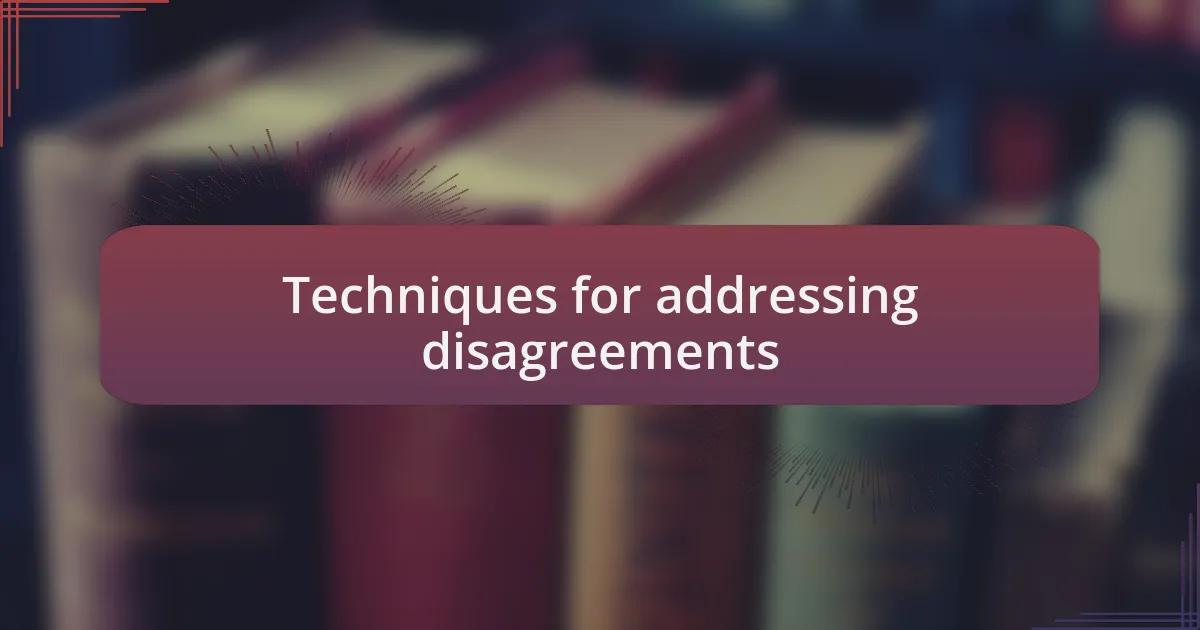
Techniques for addressing disagreements
The first technique I often rely on when disagreements arise is finding common ground. I once found myself in a disagreement with a colleague about the best promotional strategy for a new book launch. Instead of debating our points endlessly, we took a step back and identified our shared goal: increasing sales. By focusing on that common objective, we were able to brainstorm solutions that satisfied both perspectives. Isn’t it fascinating how unity can transform conversations?
Another effective technique is employing open-ended questions. I remember a time when a customer was upset about an order mix-up. Instead of making assumptions, I asked, “How did this affect your experience with us?” This approach not only encouraged the customer to share their feelings but also helped me understand the situation from their viewpoint. Isn’t it interesting how asking the right questions can lead to deeper insights and solutions?
Lastly, I find that acknowledging feelings can diffuse tension quickly. During a discussion about an out-of-stock item, I noticed my frustration mirrored that of the customer. By saying, “I completely understand why you’re upset; I would feel the same way,” I was able to validate their feelings. This simple acknowledgment shifted the conversation into a more collaborative realm. Isn’t it amazing how recognizing emotions can open doors to more constructive dialogue?
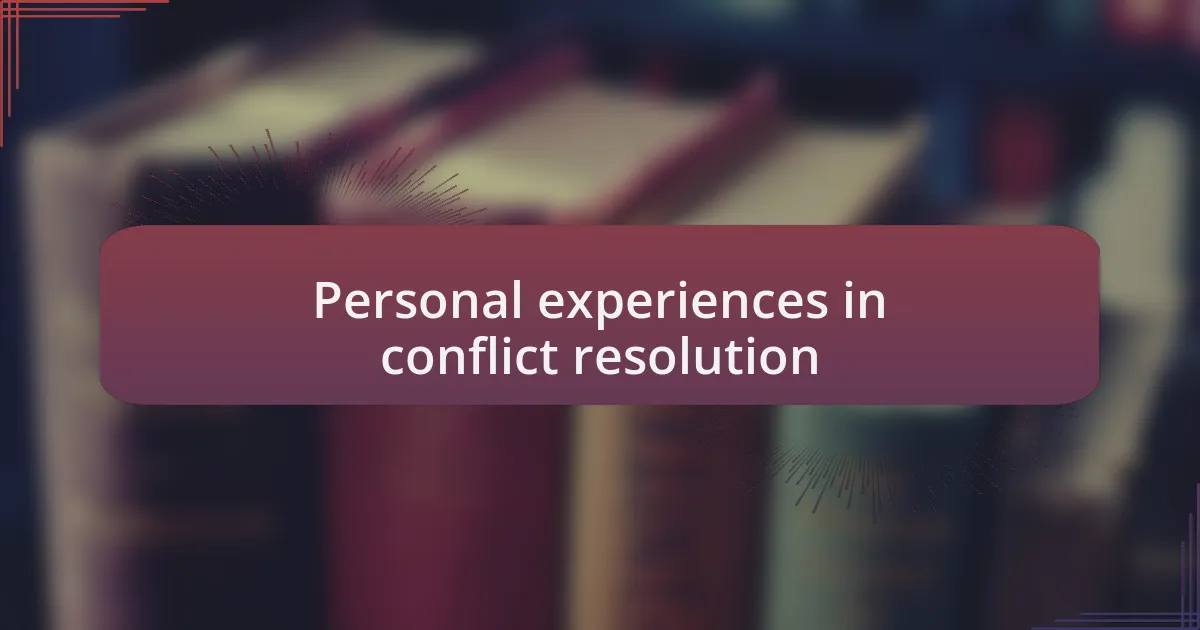
Personal experiences in conflict resolution
Throughout my journey in conflict resolution, I’ve often found that timing is everything. I recall a situation where I faced a disagreement with a team member over inventory management priorities. Instead of addressing it immediately, which would have escalated the tension, I waited for a calm moment later in the day to discuss our differing views. This allowed both of us to approach the conversation without the heat of the moment clouding our judgment. Have you ever noticed how the right timing can change the dynamics of a discussion?
Empathy plays a crucial role in resolving conflicts, as I’ve learned from personal experience. There was a time when a delivery delay led a regular customer to vent their frustration on social media. Rather than getting defensive, I reached out with a sincere apology and asked how I could make it right. This empathetic gesture not only mitigated the situation but also strengthened our relationship. Isn’t it rewarding when a simple act of understanding can turn a conflict into an opportunity for connection?
Lastly, I’ve discovered the power of follow-up after a conflict is resolved. I had an engaging conversation with a client who had reservations about a recent book purchase. After hearing their concerns and offering a solution, I decided to touch base a week later. This follow-up not only showed that I valued their opinion but also reassured them that their satisfaction was important to me. Have you ever followed up with someone after a disagreement? It can transform a fleeting issue into a lasting positive relationship.

Evaluating the outcome of resolutions
Evaluating the outcome of resolutions is essential to truly understand whether conflicts have been effectively managed. I recall a particularly tense exchange with a colleague over a promotional strategy. After we settled our differences, I made it a point to gather feedback from our team a month later. Would you believe that our initial disagreement actually led to more innovative ideas? It was gratifying to see how different perspectives can enhance overall results.
Sometimes, evaluating outcomes requires a bit of introspection. Following a misunderstanding with a supplier about delivery schedules, I took the time to reflect on what went well and what needed improvement. How often do we pause to assess not just the immediate resolution but the long-term effects? That reflection helped me cultivate a more proactive approach the next time communication faltered, ultimately leading to smoother transactions and stronger partnerships.
Not all resolutions yield immediate positive outcomes, and I’ve learned to be open to that. There was a case where my attempt to resolve an issue with a customer didn’t pan out as expected, resulting in lingering dissatisfaction. It stung, but it was an opportunity for growth. Isn’t it fascinating how even perceived failures can guide us to refine our strategies for the future? Embracing these lessons can lead to a deeper understanding of conflict resolution and, ultimately, a stronger business.